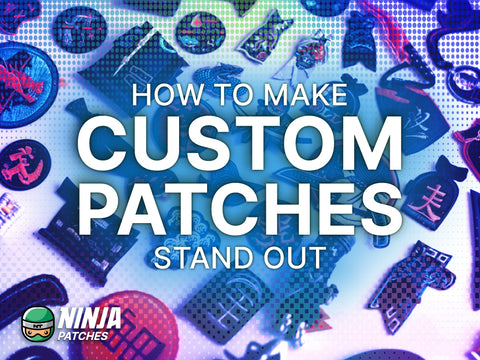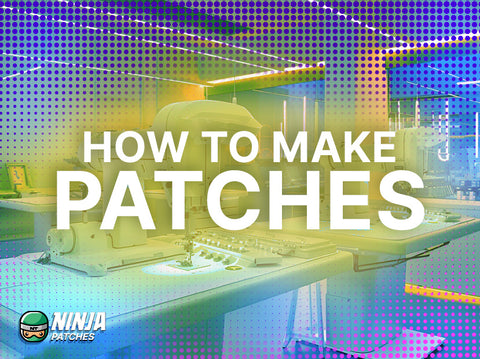Custom patches are an exciting way to showcase your style, enhance branding, and help a product or item stand out. They are both vibrant and dynamic, giving an enhanced appearance to transform ordinary apparel. Used to denote membership and celebrate achievements, there are many applications for custom patches, but making them stand out can help ensure that they are truly memorable. In this article, we’ll cover everything from design and production through to application and trending ideas, giving you what you need to know to create patches that stand out from the crowd.
Table of Contents
- Designing Your Patch
- Production Techniques
- Applying Custom Patches Effectively
- Innovative Uses & Trends
- Conclusion
Designing Your Patch
The way that you design your patch is the first step to making sure that it stands out. Choosing the right material and crafting an eye-catching design are some of the most important steps.
Choosing The Right Material
The right material, or the type of material, is the foundation for a great patch. Each material type offers different benefits to suit a wide range of needs. Embroidered patches, for example, are renowned for their classic raised texture and durability, making them perfect for outdoor gear and uniforms. Woven patches, on the other hand, offer a smoother finish with greater detail. These are ideal for intricate designs and subtle touches that can be found in business apparel. Printed patches allow for the most color and image complexity, suitable for artistic or photo-realistic designs.
Crafting An Eye-Catching Design
If you want a standout patch, then you need a standout design. That will usually start with the color scheme. The color of your patch should be chosen for maximum contrast and visibility. For instance, a bright neon border might frame a dark center to help draw the eye. Or you may have a two-color design with one of the colors highlighting the others.
When selecting images and text, make sure you make your choice for clarity and impact. Bold and simple graphics with eligible typefaces can ensure your patch can be easily read from a distance. Consider the size of the patch as well while you’re designing. You want to ensure that any details are not lost in smaller dimensions, and larger patches do not look too empty due to the extra real estate for the design.
Production Techniques
The production techniques to make your patch stand out will differ depending on whether you choose a DIY method or look for professional manufacturing, like our custom patches at Ninja Patches.
DIY Methods
If you prefer a personal touch, then learning how to make patches involves a few key steps. Make sure to sketch and then stencil your design to make sure it stays consistent, particularly if you’re creating multiple patches. Then cut out shapes from your chosen fabric. Create your patch using your chosen material and method. DIY can add a personal touch but also allow for complete control over the material and thread choices.
Professional Manufacturing
Partnering with a professional manufacturer can take your patches to the next level. Choose between different custom stitching options, such as merrowed borders. Consider the different thread types and color options - at Ninja Patches, you can even find unique options like rhinestone transfers to make your patches truly stand out. Take the stress out of creating your custom patches.
Applying Custom Patches Effectively
The impact of a custom patch hinges on how effectively they are applied to the garment or hat. Strategic positioning can help to enhance visibility and even the significance of the patch.
Placement Strategies
Some of the most common placements for patches include:
Jackets
- Back - large center patches are common statement pieces or group affiliations.
- Chest - small patches on the left chest are typically used for logos or identification. Right chest can also be used occasionally for badges or flags.
- Sleeves - patches on the upper sleeve are typical for military ranks or unit patches.
Jeans
- Thighs - front thigh patches for decorative purposes or branding.
- Knees - patches for reinforcing or stylistically covering wear and tear.
- Back Pockets - sometimes used for branding or decorative patches.
Backpacks
- Front pocket - common for decorative and identification patches.
- Flap - for larger decorative patches that need more visibility.
Hats
- Front - most common for logos or emblems on caps.
- Side - smaller patches or tags, often used for branding.
Shirts
- Chest - patches on the left chest are very common for company logos, club emblems, or other identifiers.
- Upper arm - similar to jackets, used for military or other organization symbols.
Military Uniforms
- Shoulders - shoulder patches to indicate unit affiliation.
- Chest - Above the right chest for name tapes, above the left chest for service tapes or badges.
Bags
- Front or side panels - for visible decoration or identification.
Shoes
- Tongue - for branding or special edition logos.
- Sides - decorative elements or special collaboration logos.
Attachment Techniques
The most important step to making your patch last longer and stand out is to attach them in a way that makes sure that it stays in place.
Some of the most common attachment techniques include sewing on patches, ironing on patches, using a heat press, peel and stick, and velcro. We provide different attachment techniques to help give you more versatility. However, we strongly recommend using a heat press to apply all of our patch types to ensure they last longer.
Innovative Uses & Trends
Innovative Uses & Trends
While patches are commonly seen on garments and apparel, their uses extend far beyond. Patches can add a personal touch to tote bags, create a themed look on curtains or pillows in home decor, or even personalize tech accessories like laptop bags and camera straps. Schools and clubs might use patches for book bags and team gear, offering a unified yet customizable solution for identification and expression.
Current & Future Trends
A mix of retro nostalgia and contemporary design influences today’s common patch designs. Trends show a resurgence of vintage styles, with patches that feature classic rock bands, old-school logos, and iconic symbols from the 70s and 80s. On the modern front, minimalistic designs with bold monochromatic colors are gaining popularity once again. With our rhinestone transfers and leather patches, more unique designs are also becoming increasingly popular.
Conclusion
Creating custom patches that stand out requires a blend of creativity, technique, and strategic thinking. From the initial design to the final application, each step offers opportunities to inject personality and purpose into your patches. Whether you are a designer, a hobbyist, or a business owner, understanding these elements can transform simple designs into powerful tools of expression and branding. Unleash your creativity, experiment with new ideas, and watch as your custom patches stand out and speak volumes.


